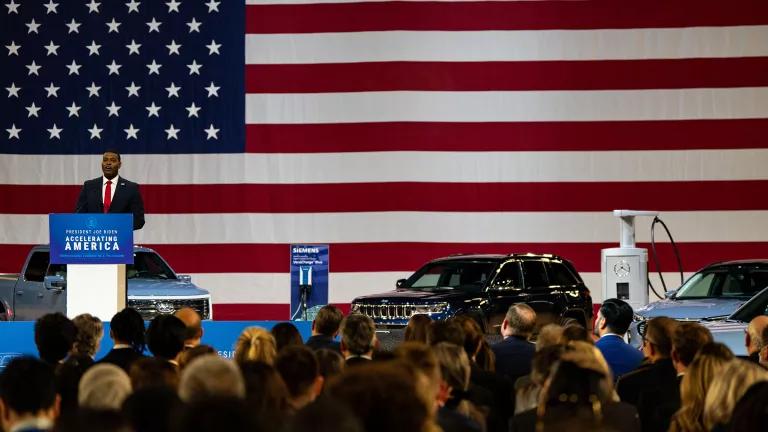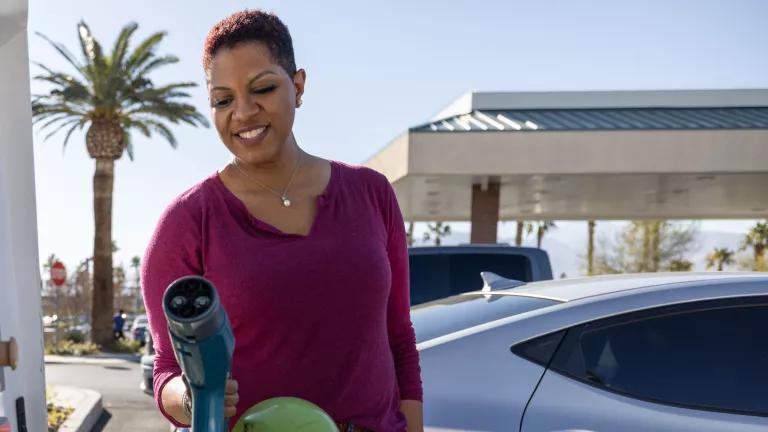Officials from the California Air Resources Board (ARB) will gather tomorrow in Riverside – a city facing among the worst air pollution in the nation – to discuss the status of the state’s clean car standards following the results of staff’s formal review.
The 16-member Air Resources Board is expected by many to reaffirm the existing standards for model years 2022-2025, based on ARB staff’s review and recommendations, giving an official green light to staying on course with the program. But the impact will be felt far beyond California because 12 other states also have adopted California’s standards, collectively protecting 113 million U.S. residents from dangerous pollution and representing over a third of the U.S. vehicle market (states include CA, CT, DE, MA, MD, ME, NJ, NY, OR, PA, RI, VT, WA as well as DC).
My colleague, Irene Gutierrez, and I will be testifying at the hearing about why the standards are vital for meeting state air quality and climate goals.
Critical Public Health and Climate-Protecting Standards
The ARB staff conducted a detailed, thorough review and concluded the state’s clean car standards can be met using known technologies at or below the costs originally anticipated in 2012. Despite automakers’ convincing the Trump Administration to reopen federal clean car standards -- the first step to weakening them – California’s Board is expected to give direction to its ARB staff to hold firm on the state’s clean car standards, which act as a critical safeguard to weakening of the federal standards, and to begin a process to consider post-2025 standards in order to fulfill state laws that mandate cuts in pollution.
Those current obligations include new carbon reduction requirements by 2030 (SB32, AB197) required by the legislature, as well as requirements to meet state and federal air quality standards by 2031. Moving forward with this critical program means California is taking the necessary steps to protect its citizens and economy from the dangers of smog, particulate matter, and carbon pollution.
Using standards to protect the public health and welfare of citizens
For half a century, California’s independent authority to set its own vehicle emissions standards has enabled the state to combat its severe air pollution problems. Should the Trump administration weaken the highly successful federal standards, state-level clean car programs are even more critical to protecting our health and reducing our fuel bills at the pump. Pressure will continue on the automakers to make clean cars for these states – representing 35% of the market – and the rest of the nation, resulting in much lower amounts of smog-forming pollution and carbon pollution being emitted.
As Board Chair Mary Nichols recently stated:
We intend to stick by the commitments that we made. If for some reason the federal government and the industry decide to abandon those agreements that we all reached, we will have to re-examine our options. If the issue is are they going to relax the standards, then we would vehemently oppose that.”
Automakers attempting to break down safeguards
Automakers know that weakening California’s clean car standards will be an uphill battle. But they are already testing the state’s resolve, arguing for weakening of the Zero Emission Vehicle (ZEV) requirements, widely acknowledged as the most important program driving zero tailpipe emission cars into the market. As I’ve blogged about before, there are many reasons why the ZEV program should be tuned-up and strengthened rather than weakened – including the fact that the effective sales requirement for 2025 is less than half than what was originally targeted back in 2012. Sales in ZEV states outside of California increased by nearly 60 percent over the past year, a good indication that the standards are working and early markets are picking up. ARB staff will recommend maintaining the requirement as-is.
Automakers are also erroneously claiming that California had previously committed to allowing them to comply with just the federal standards - instead of California's stronger standards - in the event that federal standards were weakened. This is nonsense. California, which reached an agreement in 2011 with federal agencies and automakers around a coordinated National Program, did so based on the greater environmental benefits it would deliver while still maintaining the state’s independent authority. As the Board stated publicly and in its formal Resolution when adopting the standards in January 2012.
“WHEREAS, it is staff’s intent to allow manufacturers to demonstrate compliance with California’s greenhouse gas regulations for the 2017 through 2025 model years by demonstrating compliance with the greenhouse gas requirements of the 2017 through 2025 MY National Program, provided that U.S. EPA’s Final Rule does not weaken the proposed federal standards and the Program’s reduction in greenhouse gas emissions, except that California would maintain its own reporting requirements.” [Emphasis added]
Nearly all the automakers and their associations were at that 2012 hearing as well, which I also attended. While ARB continues to support the National Program as agreed to in 2011 and finalized in 2012, it never agreed to lower its own standards if the U.S. Environmental Protection Agency and the National Highway Traffic Safety Administration were to do so. Rest assured, California does not need a permission slip to stick to its standards on the books. It’s up to the automakers to decide if they should take steps to try to abandon the agreement they made with California, EPA, and NHTSA. With 13 states and 113 million people benefiting from these clean car standards, there are ample reasons to say “yes” to California’s clean cars program and “no” to weakening standards that provide vital protections to state residents.




